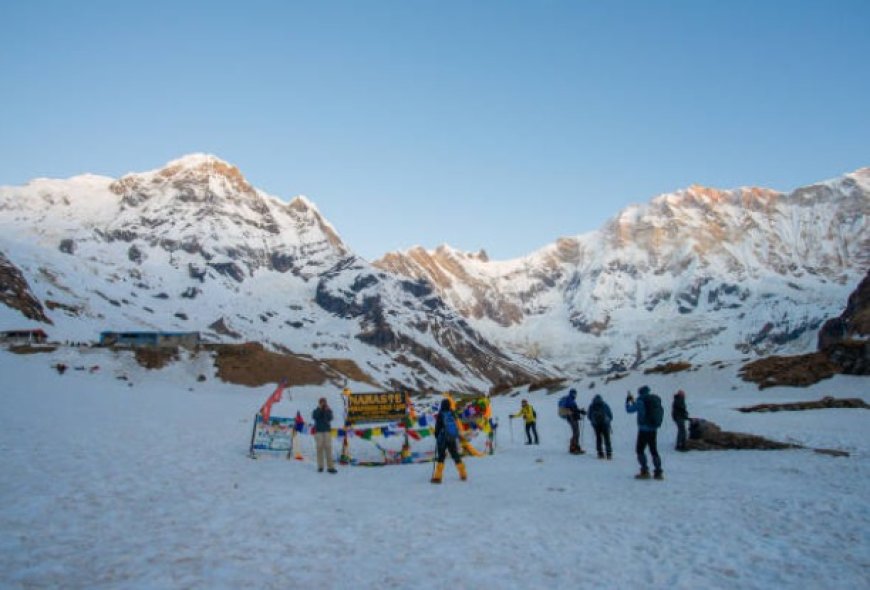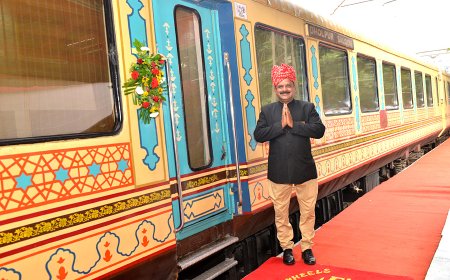How To Prepare For the Annapurna Base Camp Trek Without Failing
Discover how to prepare for the Annapurna Base Camp trek without failing. Learn essential tips on physical training, altitude sickness prevention, smart packing, gear selection, route planning, and mental readiness to ensure a safe and unforgettable Himalayan adventure.

How To Prepare For the Annapurna Base Camp Trek Without Failing
The Annapurna Base Camp trek is a stunning experience in the Himalayas, but it can be tough if youre not ready for it. Many trekkers find themselves struggling with altitude, weather changes, and the physical effort needed, which can lead to tiredness, sickness, or having to turn back early. So, getting prepared is key if you want to succeed.
Start your prep long before you hit the trail. Your body needs to be ready for long climbs and challenging paths. Doing regular cardio and strength exercises a few weeks ahead of your trip can help a lot. But being fit isn't the only thing that matters. Mental strength is huge, too. Some days can feel long, the weather can change quickly, and the air gets thinner as you go up. Staying focused and motivated is what helps people get through tough times.
Packing smart is also important. Many people either bring too much or not enough. In the Annapurna region, you have to be ready for sudden rain, cold temperatures, and long days of walking. Lightweight, moisture-wicking clothes, waterproof gear, and good shoes can make a difference. Dont forget things like water purification tablets, energy snacks, and basic altitude meds just in case.
Altitude sickness is a real concern. Rushing things without giving your body time to adjust is a sure way to run into problems. Instead, go slow, drink water often, and pay attention to how you feel. Pushing yourself too hard can ruin your whole trip.
If you mix steady training, the right equipment, and a mindset ready for both tough times and beautiful moments, the Annapurna Base Camp trek will be an unforgettable experience.
Choose the Right Season
Picking the right season for your Annapurna Base Camp trek is super important because it affects your safety and overall experience. The best times to go are right before the monsoon (March to May) and right after it (September to November). During these months, youll get clear skies and good weather. The monsoon (June to August) brings a lot of rain and slippery trails, while winter (December to February) can be icy and might close some paths. By choosing the right time, you can enjoy the stunning views without worrying too much about bad weather. If you ignore the seasons, you might end up with a tough trip. Keep an eye on the weather and try to stay flexible in your plans.
Understand the Trek Route & Itinerary.
Before you head out on the Annapurna Base Camp trail, its important to know the route and what to expect. The usual trek starts from Nayapul or Jhinu Danda, passing through places like Chhomrong, Dovan, and Deurali, and finally reaching the base camp. The whole trek usually takes about 7 to 12 days, depending on how fast you go and how well you adjust to the altitude. Knowing how high you'll go, the distances you'll cover each day, and where to stop will help you manage your energy. Its a good idea to have a detailed map or GPS instead of just relying on guides. Understanding the route will help you feel ready for the trek and spot scenic views along the way.
Build Physical Fitness Early
Getting fit is important for a successful trek to Annapurna. Start training a couple of months before you go. You dont have to be super fit, but you need to be able to walk for 68 hours each day on different terrains. Focus on cardio workouts like jogging, biking, or hiking, and do some strength training to strengthen your legs and back. Try weekend hikes with a weighted backpack to get used to it. Being fit ahead of time can help prevent injuries and tiredness on the trek. The better shape youre in, the more youll enjoy the journey and be ready to take in the views.
Train with Altitude in Mind
Altitude can be a serious issue on the Annapurna Base Camp trek, topping over 4,100 meters (13,500 feet). Youll want to get your body used to less oxygen as part of your training. If you live at sea level, try to do some hikes at higher altitudes when you can. While you can't fully mimic Himalayan conditions, doing high-intensity interval training or using altitude masks might help. Learn the signs of Acute Mountain Sickness (AMS), like headaches or dizziness, as these can become serious if ignored. Moving slowly and taking time to rest is key. Its not just about being in shape; your body needs to adapt to the altitude, and being aware helps you stay safe.
Pack Only Essentials
One of the biggest mistakes trekkers make is overpacking. Since you'll be carrying your gear for hours on steep trails, keeping your backpack lightideally under 12kg (26 lbs)is key. Bring layered clothing for changing weather, a warm sleeping bag, solid footwear, water purification tablets, a headlamp, a first aid kit, and basic toiletries. Avoid taking heavy items like multiple jeans or cooking gear, since you can find simple food and lodging along the way. Every item should have a purpose. Essentials like sunscreen, gloves, and thermal wear can boost your comfort. Pack wisely so you can move easily.
Invest in Proper Gear
Having the right gear can make or break your Annapurna trek. Invest in good waterproof hiking boots, a lightweight warm jacket, layered clothes, and a sturdy backpack. Quality trekking poles, UV-protection sunglasses, and a compact sleeping bag rated for at least -10C are smart choices too. Don't forget a solid water bottle, a hat for sun protection, and quick-dry socks. Cheap gear might break or fail when you need it most, leaving you in a tough spot. You can rent or buy some gear in Kathmandu or Pokhara, but it's best to try out important items like boots beforehand to prevent blisters.
Sort Permits and Documentation
Before you set off to Annapurna Base Camp, youll need two key permits: the TIMS Card and the ACAP. You can get these in Kathmandu or Pokhara, and you wont get through checkpoints without them. Bring several passport-size photos, a copy of your passport, and enough local currency for the fees. Its helpful to have both physical and digital copies of your permits in case anything goes wrong. Also, make sure you have travel insurance that covers high-altitude trekking and potential emergencies. While getting through border and airport formalities is generally straightforward, having your documents organized will save you from headaches later.
Prepare for AMS (Acute Mountain Sickness)
AMS is a real risk on the Annapurna trek, especially when you climb over 2,500 meters (8,200 feet). You might experience headaches, dizziness, and nausea, and if you brush these off, they can get serious. To prevent AMS, ascend slowly, take breaks to acclimatize, drink lots of water, and skip alcohol. Know when to turn back if symptoms worsen. Carrying medication like Diamox (after talking to your doctor) can help some, but it's not a substitute for good practices. Learn to spot early AMS signs in yourself and your trekking buddies. Proper preparation, rest, and being aware will help you enjoy your trek more and safely reach base camp.
Plan Accommodation and Food Stops
The Annapurna Base Camp trek features teahouses for lodging and food along the route. Most villages have teahouses, but during busy seasons, like October-November and March-April, spots can fill up quickly. Booking ahead in popular areas like Chhomrong or Deurali can save you some stress. Meals are usually simple but good, with options like dal bhat, noodles, and tea. Its wise to carry some snacks for between meals. Be prepared for hot showers, Wi-Fi, and charging to cost extra. Bring enough cash since there are no ATMs on the trek. Knowing where youll stop each night will help keep your trek on track and help you relax after long days.
Mentally Prepare for Challenges
Getting mentally ready is just as important as physical fitness for the Annapurna trek. You'll face long days of walking, unpredictable weather, basic accommodations, and fatigue. This isnt a luxury tripits an adventure that can be tough. Mentally preparing for discomfort and pushing through tough moments will help keep your spirits up. Understand that plans might change, there will be rain and cold, and the challenges are part of the experience. Techniques like visualization, playlists, journaling, or meditation can help build your mental resilience. Remember your reasons for doing thiswhether it's for the views, personal challenge, or local culture. Those who are mentally prepared often finish strong and take home the best memories.
How to Get Ready for the Annapurna Base Camp Trek
To get ready for the Annapurna Base Camp trek, you'll want to build up your fitness with cardio and leg exercises for a few weeks before you go. Pack smart with layers, waterproof gear, sturdy shoes, and trekking poles. Dont forget to get your permits and travel insurance, and plan for some rest days to help you adjust to the altitude. Being mentally prepared is important since the hike will be long, the weather can change, and accommodations are basic.
Whats the Death Rate for the Annapurna Base Camp Trek?
The death rate on the Annapurna Base Camp trek is pretty low. This trek is safer compared to the more technical climbs in the area. Most issues come from altitude sickness or accidents during bad weather. If you prepare well and take your time, fatalities are unusual. Lots of trekkers finish it safely each year.
Can Beginners Tackle the Annapurna Base Camp Trek?
Definitely! Beginners can do the Annapurna Base Camp trek if they train a bit and are in decent shape. The trail is well marked and has plenty of teahouses along the way, so you won't need any technical skills. With good prep and enough time to adjust, even first-timers can manage it.
How Difficult is the Trek to Annapurna Base Camp?
The trek is moderately challenging and usually takes about 7 to 12 days, reaching up to 4,130 meters. You'll deal with steep climbs, rough paths, and altitude issues. While its not technical, youll need to be fit and mentally tough. If you prepare well, according to your Annapurna Base Camp Trek Itinerary, most people can finish it successfully.








































